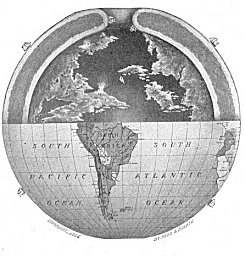
Sacred Texts Earth Mysteries

 |
The Phantom of the Polesby William Reed[1906] |
The hollow earth has long been a popular alternative theory of the shape of the earth. Typically this theory also posits large holes at the North and South Poles which would allow entry into the interior.* In his 1906 book, The Phantom of the Poles, William Reed presents a collection of reports of polar explorers on strange and unexplained phenomena, such as warm winds, deposits of dust, rocks embedded in icebergs, large ice-free areas, fresh water areas in the open polar ocean, and bizarre auroras, all in support of his belief that the polar areas are the vestibule to the interior of the hollow earth. Reed believed that the poles were unreachable because they simply didn't exist.
However, three years later, on April 6th, 1909, Peary and Henson reached the North Pole (more or less: it is now thought that they missed it by about 20 nautical miles). And so Reed's primary assertion, that the poles cannot be reached, was soon to be invalidated by facts. Today the poles have been reached by land, air and in the case of the North Pole, by submarine; there is a permanent base at the South Pole, which you can view on webcam. (You can also view the North Pole on webcam). The poles are no phantom.
In contrast to Teed and Rowbotham, Reed doesn't claim to be the messiah or that his theory is based on scriptural evidence. Nor does he attempt a far-reaching overhaul of science to make his point. Although he is wrong about the nature of the aurora (one word: magnetohydrodynamics), the origin of meteorites, and some other points, his book makes interesting reading, and conveys a sense of wonder about the cosmos.
--John Bruno Hare, 6/18/2005
* So, this sort of hollow Earth would be topologically equivalent to a donut. Umm, donuts.